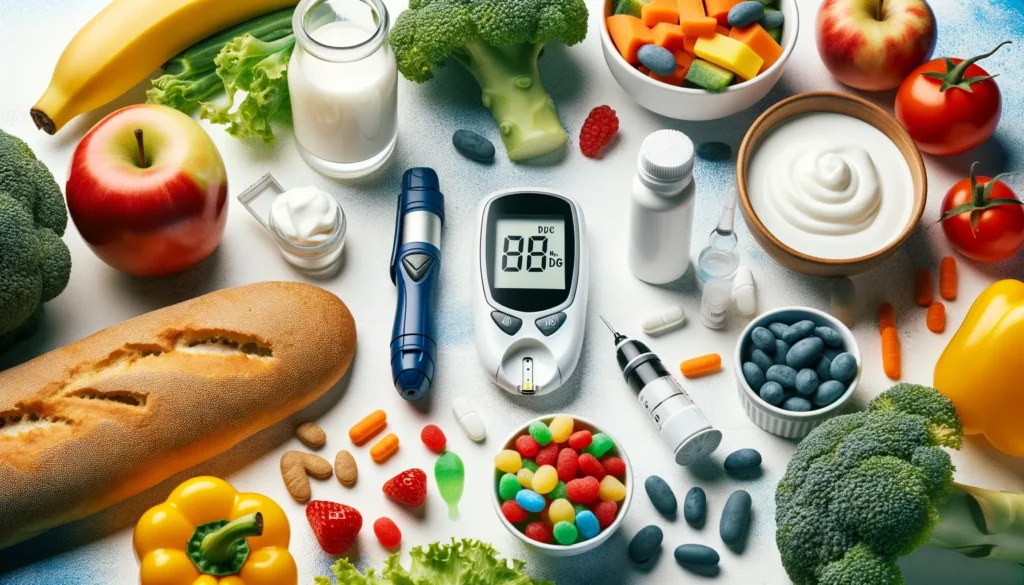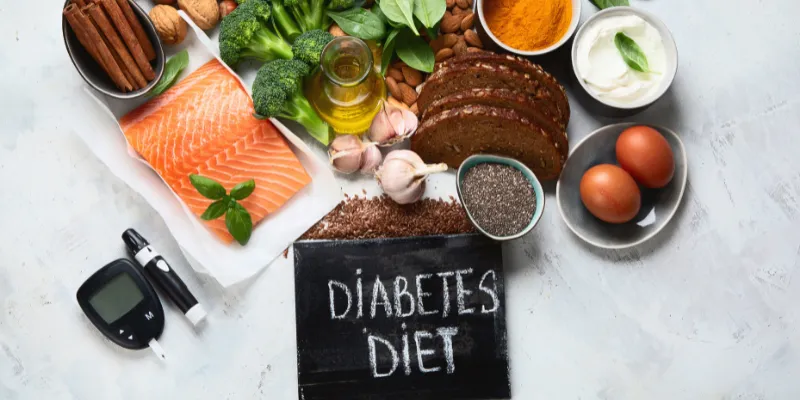A well-structured type 2 diabetes diet plan does much toward enhancing your quality of life while reducing possible complications. This is, therefore, an all-round guide designed to equip you with the necessary knowledge and tools for creating a personal meal plan in support of your diabetes management goals.
Type 2 diabetes is a chronic condition affecting millions across the world. Although medication and exercise form an integral part of it, diet remains undeniably the keystone to blood sugar management.
Understanding Type 2 Diabetes
Type 2 diabetes is a condition where the body becomes resistant to insulin, the regulatory hormone that ensures that blood sugar levels do not surge after a meal. Over time, the pancreas might not make enough insulin to counteract this resistance, thereby raising blood sugar. This occurs genetically and due to lifestyles; however, it has majorly been linked to dietary choices; therefore, dietary means of controlling this condition are very important.
The Irreplaceable Role in Type 2 Diabetes Diet Management
A type 2 diabetes diet plan is, in that sense, not another radical diet with multiple resolutions; it is a developable eating plan that gives importance to the management of blood sugar. By choosing foods wisely, you can do the following:
Keep Blood Sugar Under Control: Steady blood sugar levels inhibit harmful spikes and sudden falls.
Lower Risk of Complications: With optimal control over sugar levels, problems like heart disease, kidney damage, and nerve problems are less likely to prevail.
Promote Weight Loss: If you have excess weight, losing it will improve insulin sensitivity.
Improve Overall Health: A nutrient-dense diet for diabetes care supports good overall health.
Building Your Type 2 Diabetes Diet Plan
A type 2 diabetes diet plan is founded on whole foods, portion sizes and mindful eating.
Focus on Whole Foods
Choose unprocessed, nutrient-dense foods that provide the core of a healthy diet.
Whole Grains: Include brown rice, quinoa, whole-wheat bread, and oats for energy and fibre.
Lean Proteins: Add chicken, fish, beans, lentils, and tofu to help blood sugar levels and maintain muscle mass.
Healthy Fats: Add avocados, nuts, seeds, and olive oil for heart health and satiety.
Controlling Carbohydrates
Carbs are the body’s primary source of energy. Still, they have a different degree of effect on blood glucose.
Glycemic Index and Load: Know which carbohydrates will raise your blood sugar the most.
Portion level Control: Be calculative about your portions when it comes to carbohydrates to keep blood sugar from rising.
Low-Glycemic Choices: Eat plenty of fruits, vegetables, and whole grains that are on the low end of the glycemic index scale. Protein Power Protein is a key player in blood sugar control.
Lean Sources of Protein: Stick mostly with chicken, fish, tofu, beans, and lentils.
Portion Control: Aim for protein to be a pretty significant part of each meal.
Benefits: Protein keeps you full, does not raise blood sugar, and preserves muscle mass.
Healthy Fats
Contrary to popular belief, healthy fats are needed in a healthy diet.
Beneficial Fats: Add avocados, nuts, seeds, olive oil, and fatty fish to your meals.
Limit Unhealthy Fats: Limit saturated and trans fats by consuming fewer processed foods.
Heart Health: Healthy fats sustain heart health by reducing inflammation.
Fiber Focus
Fibre is the Superman of dietary nutrients for someone with type 2 diabetes.
Blood Sugar Control: Fiber slows down glucose absorption, heading off spikes.
Digestive Health: Fiber promotes regularity and supports gut health.
Food Sources: Incorporate whole grains, fruits, vegetables, legumes, and nuts into your diet.

Developing a Delicious and Nutritional Meal Plan
A critical aspect of managing your T2D is creating a meal plan that will be both delicious and nutritious. Here are a few sample meal ideas to kick-start your culinary journey.
Sample Meal Plans
Note: These meal plans are general and should be adjusted for portion size and food choices according to your needs and preferences. Always seek the help of a healthcare professional or registered dietitian for personal advice.
Meal Plan 1: Low-Carb Focus
- Breakfast: Greek yoghurt topped with berries and sprinkled with nuts
- Lunch: Grilled chicken salad with mixed greens and avocado, topped with vinaigrette
- Dinner: Salmon with roasted asparagus, quinoa
Meal Plan 2: Balanced Approach
- Breakfast: oatmeal with berries, drizzled with a little honey
- Lunch: Lentil soup with some whole-grain bread
- Dinner: Chicken stir-fry served with brown rice
Diabetes-Friendly Recipes
Here are some recipe ideas to help you get started:
Overnight Oats
Ingredients:
- 1/2 bowl rolled oats
- 1/2 bowl Greek yogurt
- 1/4 glass milk, plant-based or dairy
- A bowl of mixed berries
- Sprinkle of chia seeds
- Dash of cinnamon
Instructions: Combine all the ingredients in a jar and mix well. Place in the refrigerator overnight.
Grilled Salmon Fillet with Roasted Vegetables
Ingredients:
- Salmon fillets
- Mix and match colourful vegetables of your choice: broccoli, carrots, bell peppers
- Olive oil
- Herbs and spices: dill, thyme, garlic powder
Instructions: Season salmon with herbs and spices. Roast vegetables in the oven. Grill the salmon until it’s done.
Lentil Soup
Ingredients:
- lentils(green)
- Vegetable broth
- Onion, carrot, celery
- Garlic
- Spices(can modify to your taste): cumin, coriander, turmeric
Instructions: Sauté onion, carrot, celery, and garlic. Add lentils, broth, and spices and simmer until the lentils are tender.
Remember:
Play around with different flavours and ingredients to see what you like.
Monitor the portion sizes to keep blood sugar under control.
Be attentive to food labels; added sugar and unhealthy fats are often hidden.

Design your type 2 diabetes diet plan with the following steps:
Type 2 Diabetes diet plan needs proper commitment and dedication. Your diet plan for type 2 diabetes should also comprise of a variety of foods that are rich in nutrients.
Here are some other tips that would help you in the process:
Meal Prep and Planning
A part of the type 2 diabetes diet plan involves portion sizes. Eating proper portions of food aids in taking the correct amount of calories and maintaining a good weight. Maintenance of good weight is the fundamental way of controlling type 2 diabetes.An effective type 2 diabetes diet plan involves keeping a food diary. This will help in keeping track of what you eat, your blood sugar, and other symptoms. These details help fine-tune your diet and allow any necessary adjustments.
- Plan your meals: Have a weekly meal plan that keeps you organized so that you don’t end up making impulsive food choices.
- Prepare your meals in advance: Make big batches of healthy meals; it will save you a hell of a lot of time, and make sure there is always a good alternative handy.
- Pack healthy snacks: Keep a stash on you at all times of portable snacks like fruits, nuts, or yogurt to prevent unhealthy cravings.
- Water plays a vital role in any diet. As part of your type 2 diabetes diet plan, drink plenty of water and avoid some of the sweetened beverages and alcohol. Proper hydration will foster metabolic processes and general health.
Get Your Support System Involved.
- Educate your family: Share information on type 2 diabetes and the need to have a healthy diet with your loved ones.
- Support: Join a support group or talk to other people about your diabetes to share tips on how to manage this disease. Join a support group or speak with others who live with type 2 diabetes.
- Monitoring Blood Glucose: Monitor the required levels of blood sugar to adjust your diet accordingly.
- A dietician shall help in giving correct and appropriate advice and also personalize the type 2 diabetes diet plan according to needs. The professional expert shall be there to help you design some very realistic goals and develop a well-balanced meal plan.
Monitoring Regularly
- Blood sugar levels: Check your levels regularly to learn how various foods and activities will affect your levels.
- Medical Consultation: Follow up with your physician or a registered dietitian from time to time to monitor your progress and further fine-tune your diet plan and medications as needed.
While managing type 2 diabetes, one should keep in mind the foods and fruits that must be avoided in the diet chart to balance sugar levels in the blood and hence maintain good health. What follows is an integrative list of foods and fruits that must be done with caution, together with reasons showing why:
Foods to Avoid in a Type 2 Diabetes Diet Plan
1. Sugar-laden Foods/Beverages
Examples: Candy, pastries, sodas, sweetened cereals, and ice cream.
Reason: Because these types of foods may raise blood glucose quickly due to their high sugar content and very low nutritional value
2. Refined Carbohydrates
Examples: White bread, white rice, pasta.
Reason: Refined carbs may increase blood sugar rapidly due to processing and lack of fibre and other essential nutrients.
3. Fried Foods
Examples: French fries, fried chicken, and doughnuts.
Reason: Fried foods are high in useless fats and calories—these can lead to weight increase and insulin resistance.
4. Full-Fat Dairy Products
Examples: Whole milk, full-fat cheese, and cream.
Reason: These, in particular, contain saturated fats. These can elevate blood cholesterol and increase heart disease risk, a common complication of type 2 diabetes.
5. Processed Meats
Examples: Bacon, sausages, deli meats.
Reason: Processed meats frequently have high levels of sodium and preservatives that can raise blood pressure and negatively impact cardiovascular health.
6. Sugary Sauces and Condiments
Examples: Ketchup, barbecue sauce, and sweet salad dressings
Reason: These can be high in added sugars, which will spike blood sugar levels
7. High-Sugar Alcoholic Beverages
Examples: Sweet wines, cocktails with sugary mixers, and liqueurs.
Reason: Alcoholic beverages with added sugars usually elevate blood sugar levels and make diabetes management extremely unstable.
Fruits to Avoid or Limit in a Type 2 Diabetes Diet Plan
1. Bananas
Reason: These fruits are high in natural sugars and, hence, more carbohydrates in general, which can cause blood sugar spikes. Have lower sugar-based fruits instead.
2. Grapes
Reason: Grapes are very sweet in sugar content. In addition to this, their size allows one to easily eat a quite large quantity at one time. This can have a great impact on your blood sugar level.
3. Pineapple
Reason: Pineapple has a rather high glycemic index—this means it raises blood glucose quickly.
4. Mangoes
Reason: Mangoes are rather sweet and raise blood sugar significantly. Moderation, therefore, becomes the key if one is to include them in their diet.
5. Cherries
6. Dates
Reason: Dates are ultra high in sugar and carbohydrates, both of which will shoot up your blood glucose.
7. Dried Fruits
Example: Raisins, dried apricots, dried figs
Reason: When compared to fresh fruit, dried fruits are much denser in both sugar and calories and, hence, not that ideal for blood sugar management.
Lifestyle Modifications
Physical Activity: Perform at least 150 minutes of moderate-intensity physical activity each week.
Stress Management: Keep stress as low as possible. Practice relaxation techniques, including meditation and yoga, because sometimes stress tends to raise your blood sugar.
Adequate sleep: Aim for 7-9 hours of good-quality sleep per night to keep overall wellness and blood sugar regulation healthy.
Overcoming the Hurdles
Keep moving forward: Managing type 2 diabetes is for life. Enjoy little success stories, and learn from those not so much on your side.
Seek professional help: If you think that you are really having a hard time, seek the help of a registered dietitian or diabetes educator.
Such tips, inculcated into your daily routine, shall help you manage your type 2 diabetes better and boost your well-being. Remember, small and continuous changes will surprisingly improve your health.
Conclusion
Designing a type 2 diabetes diet plan is hence very much a step toward better health and well-being. Mastering the basics of carbohydrate control, the role of whole foods, and how to work in physical activity empowers an individual to keep blood sugar levels under control and diminishes the risk of complications. Keep in mind that it’s all about the small changes. The key to overall health will be in some very minor diet and lifestyle changes.
While this article is very information-rich, it is in the best interest of every individual to consult a professional health expert or, at the very least, meet with a registered dietitian to get a tailor-made diet plan that will suit your specific needs and medical conditions. Thus, you can be committed to managing your type-2 diabetes problem with proper care and support and the right approach to enjoying a fuller life.
